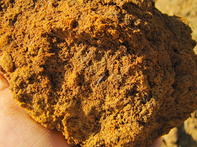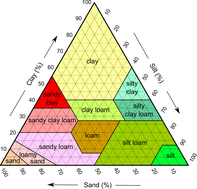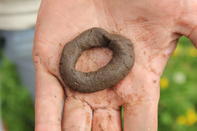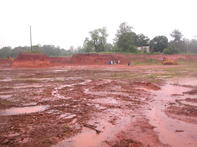Soil texture has an effect on soil fertility, influences compaction and crusting of the soil and workability - the ease with which soil can be tilled.

In addition, the texture of a soil and its clay content are the most important factors that determine the amount of air in the soil and its water-holding capacity - how easily water is retained in the soil.
Soil Texture

The texture of soil refers to the size of the soil particles. For example, sand particles are much larger than clay particles. Sand particles range from 0.05 to 2.0 mm, silt particles are between 0.002 and 0.05 mm in diameter while clay particles are less than 0.002 mm in size. Gravel or rock particles are larger than 2 mm and are not considered when determining soil texture.
In terms of texture, soils can be classified into four classes: sandy, silt, loamy and clay. The class of soil is determined by the proportion of the different soil particles. Sandy soil has a coarse texture while a clay soil is fine-textured and consists of tiny clay particles.
Clay particles are sticky and lend a strong physical property to soil, so a soil with only 20% clay can behave as a gummy clayey soil. ‘Loam soil’ refers to a soil that has sand, silt and clay particles. For example, a sandy clay loam consists of 30% clay, 50% sand and 20% silt particles.
How to Determine Soil Texture

When in the field, pick up a handful of soil and add a bit of water to form a ball. If you cannot make a ball, the soil is sandy. Feel the texture of the soil with your fingers to see if it is grainy (sand), silky or floury (silt) or plastic (clay).
A laboratory can test the texture of soil but a farmer can use the ‘sausage method’ to determine the texture of soil on his farm. Researchers of South Africa’s Water Research Commission has compiled this easy test to determine soil texture:
Sand
Sand has a clay content of less than 10%. It does not form a ‘sausage’ but, depending on the clay content, may form a stable ball.
Loamy sand
Has a 10 - 15% clay content. Grains are of medium size and can be smeared between thumb and forefinger. Forms a brittle ‘sausage’.
Sandy loam
Has a 15 - 20% clay content. Can form a thick ‘sausage’ but breaks apart with slight pressure.
Sandy clay loam
Has a 20 - 35% clay content. Rolls into a stable ‘sausage’ but breaks when formed into a U-shape.
Clay loam
Contains 27 - 40% clay. Forms a stable U-shape, but breaks when formed into a doughnut or ring.
Sandy clay
Has a 35 - 50% clay content. It shows the properties of clay, but also grittiness when rubbed. Breaks when a ring is formed.
Clay
Has more than 50% clay. Soil forms a stable ring without cracking and shows an absence of grittiness.
Crops and Soil Texture

Soil texture determines the rate at which water drains through the soil and consequently how much water is available to the plant. Sand particles in a soil facilitate drainage and aeration of the soil.
Sandy soil has a much lower water holding capacity than clay soil so water and fertiliser may be added more regularly to sandy soils than to clay soils. Organic matter also breaks down faster in soil with a higher sand content as there will be more air present in soils with larger particle size - the decomposition process of organic matter requires oxygen.
In addition, well-drained soils have a higher air content, which contributes to healthier plant roots. Soils with a higher clay content can store more nutrients and water because soil with small clay particles has a large surface area per unit volume.
Clay particles are negatively charged and therefore have positive ions and can hold onto or adsorb, positively charged elements such as ammonium (a nitrogen-compound), potassium, calcium, magnesium and other trace elements. A soil’s ability to resist pH change is mainly determined by organic matter and clay content. Loamy soils are considered the best soils for most crops.